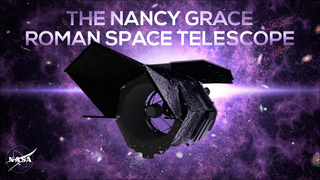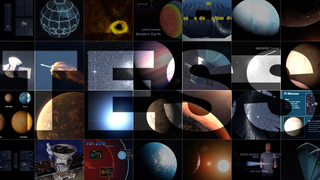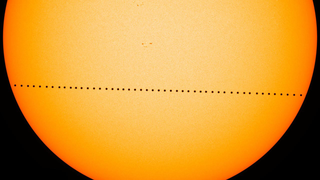Universe
ID: 13266
A planet discovered by NASA’s Transiting Exoplanet Survey Satellite (TESS) has pointed the way to additional worlds orbiting the same star, one of which is located in the star’s habitable zone. If made of rock, this planet may be around twice Earth’s size.
The new worlds orbit a star named GJ 357, an M-type dwarf about one-third the Sun’s mass and size and about 40% cooler that our star. The system is located 31 light-years away in the constellation Hydra. In February, TESS cameras caught the star dimming slightly every 3.9 days, revealing the presence of a transiting exoplanet — a world beyond our solar system — that passes across the face of its star during every orbit and briefly dims the star’s light.
The transits TESS observed belong to GJ 357 b, a planet about 22% larger than Earth. It orbits 11 times closer to its star than Mercury does our Sun.
But while researchers were looking at ground-based data to confirm the existence of the hot Earth, they uncovered two additional worlds. The farthest-known planet, named GJ 357 d, is especially intriguing. The planet’s size and composition are unknown, but a rocky world with this mass would range from about one to two times Earth’s size.
GJ 357 d is located within the outer edge of its star’s habitable zone, where it receives about the same amount of stellar energy from its star as Mars does from the Sun. If the planet has a dense atmosphere, which will take future studies to determine, it could trap enough heat to warm the planet and allow liquid water on its surface.
GJ 357 c, the middle planet, has a mass at least 3.4 times Earth’s, orbits the star every 9.1 days at a distance a bit more than twice that of GJ 357 b. TESS did not observe transits from this planet, which suggests its orbit is slightly tilted — perhaps by less than 1 degree — relative to the hot Earth’s orbit, so it never passes across the star from our perspective.
TESS Discovery Leads to Surprising Find of Promising World
The new worlds orbit a star named GJ 357, an M-type dwarf about one-third the Sun’s mass and size and about 40% cooler that our star. The system is located 31 light-years away in the constellation Hydra. In February, TESS cameras caught the star dimming slightly every 3.9 days, revealing the presence of a transiting exoplanet — a world beyond our solar system — that passes across the face of its star during every orbit and briefly dims the star’s light.
The transits TESS observed belong to GJ 357 b, a planet about 22% larger than Earth. It orbits 11 times closer to its star than Mercury does our Sun.
But while researchers were looking at ground-based data to confirm the existence of the hot Earth, they uncovered two additional worlds. The farthest-known planet, named GJ 357 d, is especially intriguing. The planet’s size and composition are unknown, but a rocky world with this mass would range from about one to two times Earth’s size.
GJ 357 d is located within the outer edge of its star’s habitable zone, where it receives about the same amount of stellar energy from its star as Mars does from the Sun. If the planet has a dense atmosphere, which will take future studies to determine, it could trap enough heat to warm the planet and allow liquid water on its surface.
GJ 357 c, the middle planet, has a mass at least 3.4 times Earth’s, orbits the star every 9.1 days at a distance a bit more than twice that of GJ 357 b. TESS did not observe transits from this planet, which suggests its orbit is slightly tilted — perhaps by less than 1 degree — relative to the hot Earth’s orbit, so it never passes across the star from our perspective.
Used Elsewhere In
Related
For More Information
Credits
Chris Smith (USRA): Lead Producer
Chris Smith (USRA): Lead Animator
Francis Reddy (University of Maryland College Park): Lead Science Writer
Chris Smith (USRA): Lead Animator
Francis Reddy (University of Maryland College Park): Lead Science Writer
Please give credit for this item to:
NASA's Goddard Space Flight Center. However, individual items should be credited as indicated above.
Science Paper:
https://www.aanda.org/component/article?access=doi&doi=10.1051/0004-6361/201935801
Short URL to share this page:
https://svs.gsfc.nasa.gov/13266
Mission:
TESS
This item is part of these series:
Narrated Movies
Astrophysics Animations
Astrophysics Features
Keywords:
SVS >> HDTV
SVS >> Transit
SVS >> Astrophysics
SVS >> Planets
SVS >> Star
NASA Science >> Universe
SVS >> Exoplanet
SVS >> TESS
https://www.aanda.org/component/article?access=doi&doi=10.1051/0004-6361/201935801
Short URL to share this page:
https://svs.gsfc.nasa.gov/13266
Mission:
TESS
This item is part of these series:
Narrated Movies
Astrophysics Animations
Astrophysics Features
Keywords:
SVS >> HDTV
SVS >> Transit
SVS >> Astrophysics
SVS >> Planets
SVS >> Star
NASA Science >> Universe
SVS >> Exoplanet
SVS >> TESS















